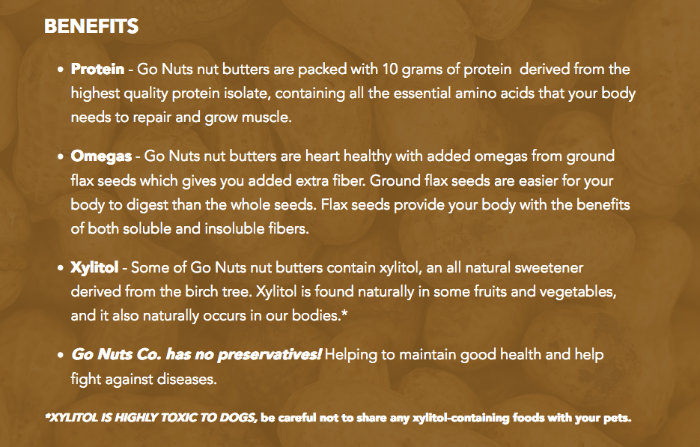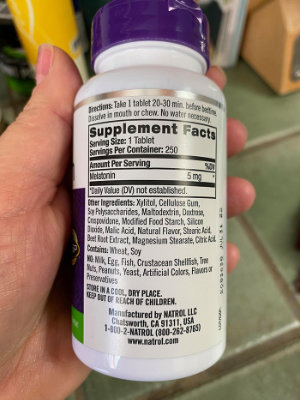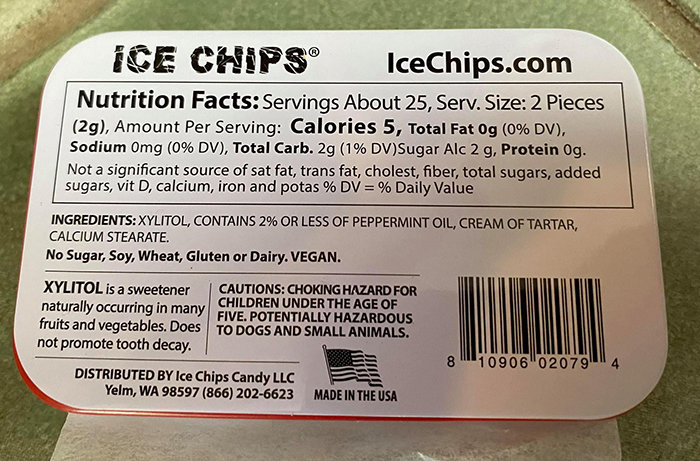A friend recently had a terrible scare with a dog who ate a homemade cinnamon bun and got hideously ill; it turned out that the glaze on the bun was made with an artificial maple syrup that contained xylitol.
You may have heard that xylitol is toxic to dogs, and that you should never leave sugarless gum or mints that may have xylitol in them anywhere dogs can get them. (This includes in your purse or backpack, in the car, on your bedside table, or anywhere else your dog may have access to.) But are you aware how many MORE foods, medicines, supplements, and oral health products contain xylitol?
Xylitol, also known as “birch sugar” or ”wood sugar” (it’s made from birch and other wood products), is more and more commonly used in products for humans. It’s used in candies and baked goods meant for diabetics, as it sweetens foods in a way that does not cause an increase in a human’s blood glucose or insulin levels. But its use is not always called out as being appropriate for diabetics; increasingly, it’s used in regular baked goods, because it’s heat-stable (it doesn’t caramelize like regular sugar does).

It’s commonly found in:
- Toothpastes, mouthwashes, breath mints.
- Cough syrup and cough drops.
- Children’s and adult chewable vitamins.
- Supplements and over-the-counter medications. (One friend noticed it on the label of the melatonin supplement she takes to help her sleep; imagine if she left the bottle on her bedside table and one of her dogs helped themselves to the bottle?)
- “Skinny” or low-calorie ice cream.
- “Low-calorie” desserts of any kind (cookies, cakes, “energy” bars).
- Peanut butters and other nut butters. (This last one is particularly scary, as many people use peanut butter to “stuff” their dogs’ Kong or other food-puzzle toys. Always check the label of nut butters and any other food you use in a Kong, Toppl, or other food-dispensing toy!)

It also doesn’t take very much xylitol at all to seriously sicken or kill a dog. According to the U.S. Food and Drug Administration, symptoms of xylitol toxicity in a dog include vomiting, followed immediately by symptoms associated with the sudden lowering of your dog’s blood sugar, such as decreased activity, weakness, staggering, incoordination, collapse, and seizures.
In dogs, xylitol is quickly absorbed into the bloodstream, and may result in a potent release of insulin from the pancreas. This rapid release of insulin may result in a rapid and profound decrease in the level of blood sugar (hypoglycemia), an effect that can occur within 10 to 60 minutes of eating the xylitol. Untreated, this hypoglycemia can quickly be life-threatening.
The FDA advises: “If you think your dog has eaten xylitol, take him to your vet or an emergency animal hospital immediately. Because hypoglycemia and other serious adverse effects may not occur in some cases for up to 12 to 24 hours, your dog may need to be hospitalized for medical monitoring.”

Prevention is key
The best way to prevent your dog from an accidental poisoning is to not buy products that contain xylitol, so they just are never in your car or house. But if you do have mints, toothpaste, cookies, or anything else in your home that contains xylitol, you must manage its presence in your possession like you would a loaded gun in a house full of toddlers. Keep any item –including toothpaste! – in a closed cabinet where the dog cannot possibly reach, never just on a kitchen or bathroom counter that a dog might be able to jump up and reach. If your dog is not a “counter surfer,” you may tend to be casual about items like toothpaste in the bathroom or mints on the coffee table. But a guest’s dog may be different – and all counter-surfers start somewhere, with some food item. You’d hate for your dog’s first foray into helping himself to some xylitol-containing food or supplement to be his very last meal ever.
Lastly, bipartisan legislation (called the Paws Off Act of 2021) that would require manufacturers of any product containing xylitol to include a warning label has been introduced in Congress. You can find more information and support the Paws Off Act by contacting your representative here.







Is it required to include Xylitol on a food label? If it does NOT appear on my peanut butter jar’s label, does that mean it isn’t there? Or should I call the company to ensure that Xylitol is not present? Thanks for your great blog!
Thanks for asking! It IS required on FOOD labels. So if the peanut butter does not have it listed, it is NOT there. It’s the mouthwashes and medicines and miscellaneous things where it might not be listed.
Great article. Thank you. The word ”great” does not do justice to how crucially important this information is.
Please repeat this information and update the article on a regular basis. It is surprising how many people do not know and even more shocking how many products contain it.
We caused this problem by, first, buying products with the ingredient, and then, two, by not complaining to the companies to find alternatives – like any active consumer would and should do about all products on the market with which they interact.
Just because it is in products, it does not mean it must be in products.
WOW, You are so right about all of it!!! I personally think that Xylitol should be ban from any kind of use in any kind of product ever produced on this planet in the United States at all!!! NEEDS TO BE FULLY BANNED 1000%!!!
Thanks for that info!!!!
Great article!!I was totally unaware of xylitol. Thank you.
I just found xylitol in some low-cal salad dressing!! (and yes, I have fed my dogs leftover dressed salad off my plate before). I did not buy said low-cal dressing, I was just checking labels in the store.
Xylitol is being rebranded as Birch Sugar. Keep a close watch out for either.
Yes it will be listed on the food label.
Many thanks for the great info/reminder! It is amazing and surprising where it is found. I always check ingredients on skin care products for different reasons, (concerns for both myself and my dogs). I recently looked at some products I was interested in from an upscale “natural” line and was surprised to find xylitol in several of the products. I sent an on line inquiry as to why it was needed in the products but never received an answer.
I did the same thing. Completely surprised how often it is listed as in ingredient in lotions, skin care products and make-up. I know it’s minor, but what if my dog licks my face….he would be ingesting a miniscule amount of it. But who is to say how much is necessary to harm my dog. I won’t take a chance. I emailed the maker of a skin care line that included it in their products and have yet to get a response.
Xylitol can also be found listed as E967 (its European code.)
Please, repost this article about “Xylitol, Toxicity to Dogs” often with new updates! Because you wouldn’t believe how many don’t know about this critical piece of information, whether they have dog’s or not. But everyone needs to know about this deadly product. I love all your articles!!! You’re a great writer with a lot of passion about what you write about! Never stop writing!!! Thanks for all your hard work and passion 💜 ❤ 💕 💙
I went to a healthfood store recently and found SEVERAL products which contained xylitol in them. I talked with the manager about putting a sign that informs consumers about the dangers of xylitol to dogs and was told they would not do that, as the consumer should do their own research. I don’t know how it would hurt to put up a small sign…….
Scary, too, that xylitol is an alternate ingredient for sugar in tons of home recipes. Think I’m going to start asking friends who want to share cookies what they use for a sweetener.
I am particularly distressed to learn that xylitol is used in a brand of Melatonin. Back in the early 2000’s I had a Dachshund who suffered from a genetic problem where the melanin clumped on her individual hairs, causing them to break off and making her appear bald. Her canine dermatologist and regular veterinarian both recommended melatonin because, in some cases, it improved the fur. I never used the Costco brand and I’m an inveterate label reader, but the news still disturbs me. Mitzi took it for years.
My dog got some from gummy bears, packed as a gift, at Christmas. He survived then but died suddenly a few months later.??
Does anyone know if this affects cats too?
My dog is recovering right now from a eating a lethal amount of xylitol. Her ALT was over 7,299. Yes, that number is correct. 2.5 days in the ER, 1.5 days in a specialty vet and 2 blood transfusions later she is alive. Her blood stopped clotting. It was a nightmare. She is on the road to recovery. She will be 10 years old in 2 weeks snd has MVD B2, and 5/6 heart murmur. It’s a miracle she survived.
In 2009 my son put his 3 dogs in their room while he went to work for the day. He came home to find Rocky (a pointed) and Chase (a long hair chihuahua) dead. Sadly we found that apparently when he bent down to set their gate in place a pack of icebreakers gum fell out of his pocket and he did not notice it – but they did. We learned the hard way about the danger of xylitol. Our local news station did a story on this to alert people to the danger and it was amazing how many people had no idea of how dangerous xylitol was to their pets.